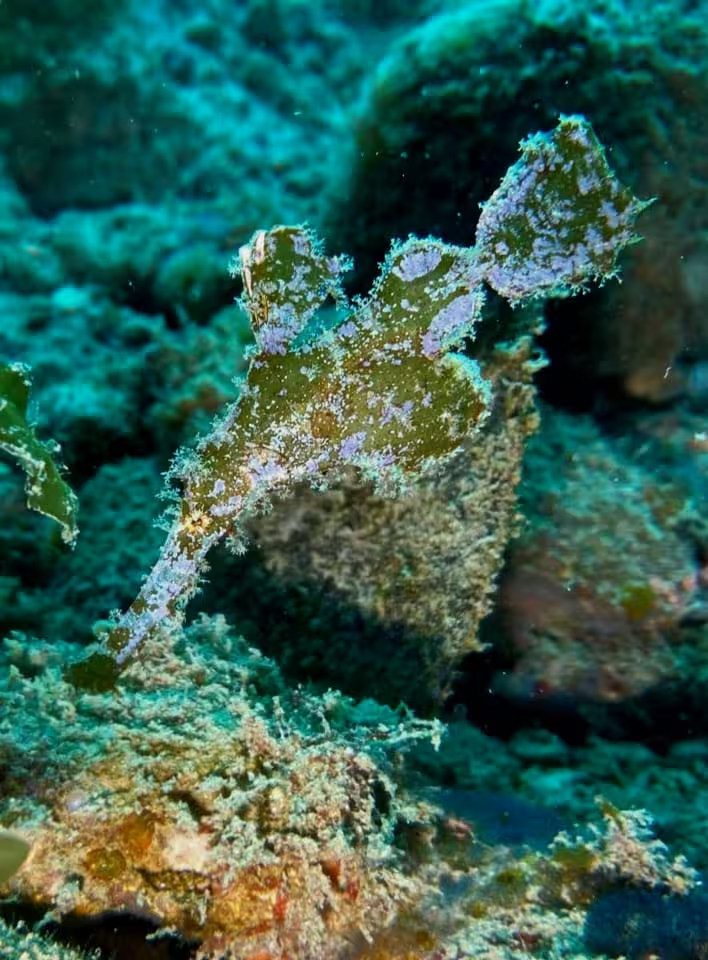Ghost Pipefish
The Ghost Pipefish

Introduction to Ghost Pipefish
The term “pipefish” refers to a group of elongated fish belonging to the family Syngnathidae, which also includes seahorses and the lesser-known ghost pipefish. These unique creatures are characterized by their distinctive tubular bodies and elongated snouts, which they use to feed on small crustaceans. Pipefish can be found in various marine environments, ranging from shallow coastal waters to deeper oceanic habitats. Among the many species within this family, the ghost pipefish stands out due to its remarkable ability to blend seamlessly into its surroundings, making it a fascinating subject for marine enthusiasts and researchers alike.
Ghost pipefish, classified under the genus Solenostomus, are intriguing marine fishes that exhibit a plethora of unique traits. Unlike their more common relatives, ghost pipefish exhibit a cryptic appearance, often camouflaging themselves among coral reefs, feather stars, and other underwater structures. This exceptional skill for disguise serves as both a hunting technique and a defense mechanism against predators. With their slender bodies and tendency to remain motionless, ghost pipefish are often mistaken for floating debris or plant life in the vibrant marine ecosystem.
The ghost pipefish species are typically small, with adults not exceeding 17 centimeters in length. They are found predominantly in the tropical waters of the Indo-Pacific region, with a notable presence in areas like Indonesia and the Philippines. As members of the Syngnathiformes order, ghost pipefish share several characteristics with other pipefish species, yet they possess distinct features that define them as a unique group. Understanding the biology and behavior of ghost pipefish provides valuable insight into the ecological roles these enigmatic creatures play within their environments.
Types of Ghost Pipefish
Ornate Ghost Pipefish
The Ornate Ghost Pipefish, scientifically known as Solenostomus paradoxus, is perhaps the most recognized species within the ghost pipefish family. This remarkable marine creature exhibits an elaborate and unusual appearance that captivates marine enthusiasts and researchers alike. It possesses a distinct seahorse-like head that seamlessly transitions into a long, slender body adorned with filaments and protrusions, allowing it to blend effortlessly into its surroundings. The body of the Ornate Ghost Pipefish is characterized by its delicate structure and vibrant colors, which can change to match the environment, enhancing its camouflage against potential predators.
One of the most striking features of the Ornate Ghost Pipefish is its wide fan-like tail, which aids in maneuverability as it floats nearly motionlessly in the water. This specialized tail, coupled with its elongated snout, allows the fish to expertly ambush tiny crustaceans, which form a crucial part of its diet. The presence of a brooding pouch in females is another notable attribute of the Ornate Ghost Pipefish; unlike many other fish species, it is the female that carries the eggs until they hatch, showcasing a fascinating aspect of its reproductive behavior.
In terms of habitat, the Ornate Ghost Pipefish prefers tropical waters where it can find refuge among larger marine flora and fauna. It often resides in the company of feather stars, sea fans, and other corals, which provide both shelter and hunting opportunities. These fish are typically seen in small social groups, where they exhibit intriguing social interactions. The Ornate Ghost Pipefish’s unique adaptations and behaviors make it a fascinating subject for study, as researchers continue to unravel the mysteries surrounding its life cycle and ecological role.

Habitat of Ghost Pipefish
Ghost pipefish are primarily found in the tropical waters of the Indo-Pacific region, with a notable presence from the east coast of Africa all the way to Fiji. Various species, including the ornate ghost pipefish and the Halimeda ghost pipefish, thrive in these warm marine environments. Their distribution is particularly concentrated in areas such as Indonesia and the Philippines, where the combination of diverse habitats and abundant marine life provides ideal conditions for these unique creatures.
These fascinating fish typically inhabit regions with some current, often seeking refuge among larger structures in the environment. Ghost pipefish can commonly be spotted hiding in dense areas such as feather stars, sea fans, and black corals. They have also been observed in more unconventional hiding spots, including discarded trash, demonstrating their adaptability and reliance on camouflage for protection from predators. This behavior not only helps them avoid detection but also allows them to ambush their prey effectively.
The habitat preferences of ghost pipefish reflect their unique physiological traits, such as their ability to blend into their surroundings through color changes and body shape modifications. Their preference for coral reefs and muddy bottoms during breeding seasons further illustrates the significance of specific marine ecosystems in their life cycle. While much about their habitat remains to be fully understood, it is clear that the ecological conditions in which ghost pipefish are found play a crucial role in their survival and reproductive success.
Feeding and Behavior
Feeding and Behavior
Ghost pipefish exhibit fascinating feeding behaviors that reflect their unique adaptations to their marine environment. As ambush predators, they rely on their exceptional camouflage to blend into their surroundings, making them nearly invisible to both prey and potential threats. Their diet primarily consists of small crustaceans, which they capture using their elongated snouts. With a flick of their head, ghost pipefish can quickly suck in unsuspecting prey, showcasing their effective hunting technique. This feeding strategy is particularly successful in the diverse habitats they occupy, from coral reefs to muddy bottoms.
Behaviorally, ghost pipefish display a range of intriguing traits that enhance their survival in the wild. They tend to float motionless in the water column, with their bodies oriented vertically and their mouths directed downward. This position, combined with their ability to change color and pattern, allows them to effectively hide among corals, sea fans, and other marine structures. During the breeding season, ghost pipefish exhibit a fascinating change in behavior as they seek out mates and find suitable locations for laying eggs. Females utilize their enlarged pelvic fins as a brooding pouch, allowing them to carry and protect their developing eggs until they hatch.
In social settings, ghost pipefish are often observed in small groups, displaying a level of social interaction that is not fully understood. They ability to camouflage aids in avoiding predation while they interact with others of their species. The dynamics of these social groups, however, remain largely a mystery, as researchers continue to gather data on their life cycles and behaviors. Overall, the ghost pipefish’s feeding habits and behavioral adaptations are critical to its survival, allowing it to thrive in the diverse ecosystems of the Indo-Pacific.

Conservation and Threats
Current Threats Facing Ghost Pipefish Populations
The ghost pipefish species, including the ornate ghost pipefish and the Halimeda ghost pipefish, face several pressing threats that endanger their populations. One of the most significant issues confronting them is habitat destruction, particularly due to coastal development and pollution. Coral reefs, where ghost pipefish typically find refuge and breeding grounds, are being increasingly damaged by activities such as construction, destructive fishing practices, and climate change. As the ecosystems that support these unique fish are compromised, their chances of survival diminish.
Impact of Climate Change
Climate change poses another critical threat to ghost pipefish species. Rising sea temperatures can disrupt the intricate balance of marine ecosystems, leading to coral bleaching and a decline in available food sources. These changes can affect the ghost pipefish’s ability to camouflage themselves effectively, as their survival relies heavily on being able to blend into their surroundings. Furthermore, ocean acidification resulting from increased carbon dioxide levels can weaken the coral structures that ghost pipefish depend on for protection and breeding, reducing their overall habitat viability.
Overfishing and Pollution
Overfishing is another major concern for ghost pipefish populations. As fishing pressures increase, the delicate balance of marine life can be disrupted, impacting the availability of small crustaceans that ghost pipefish feed on. Additionally, pollution from land-based sources can introduce harmful toxins into the marine environment, further stressing these unique fish. The accumulation of plastic waste and chemical runoff can degrade their habitats and pose direct risks to their health and reproductive success. These factors collectively highlight the urgent need for conservation efforts aimed at protecting the ghost pipefish and their habitats from further decline.
Conclusion
The ghost pipefish, belonging to the unique genus Solenostomus, plays a crucial role in the marine ecosystems of the Indo-Pacific. These fascinating creatures are not only remarkable for their ability to blend seamlessly into their surroundings, but they also contribute to the balance of their habitats. By preying on tiny crustaceans, ghost pipefish help maintain the population of these organisms, which in turn supports the overall health of the coral reefs and other marine environments where they reside. The intricate relationships they have with their surroundings underscore their importance as both predators and prey, acting as a vital link in the food web.
In addition to their ecological significance, ghost pipefish are also of interest to researchers and marine enthusiasts alike. Their unique anatomical features, such as the presence of pelvic fins and their distinctive brooding behaviors, offer insights into the evolutionary adaptations of marine fishes. The various ghost pipefish species, including the ornate ghost pipefish and halimeda ghost pipefish, exhibit a wide range of morphological diversity, allowing researchers to study the impacts of environmental factors on their development and behavior. This makes them a focal point for studies aimed at understanding the complexities of marine life.
Furthermore, the enigmatic lifestyle of ghost pipefish, including their mysterious life cycles and social interactions, continues to intrigue scientists. Their ability to change color and shape for camouflage highlights the evolutionary strategies employed by marine species to survive in their environments. As research advances, ghost pipefish may reveal more about the interconnectedness of marine species and the fragility of their ecosystems, emphasizing the need for conservation efforts to protect these stunning creatures and their habitats.



